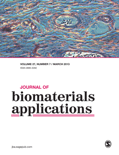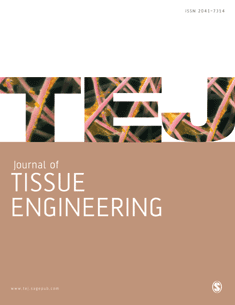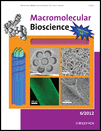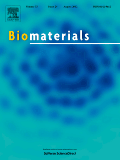
Biofabrication
Scope & Guideline
Elevating Knowledge in Biomaterials and Biomedical Engineering.
Introduction
Aims and Scopes
- Tissue Engineering and Regenerative Medicine:
Research in this area encompasses the creation of biological constructs that can replace or repair damaged tissues and organs, utilizing various biofabrication techniques. - Bioprinting Technologies:
The journal emphasizes advancements in bioprinting methodologies, including 3D bioprinting and bioprinting of complex tissue structures, to enhance precision and functionality. - Biomaterials Development:
A core focus on the design and application of novel biomaterials, including bioinks derived from natural and synthetic sources, to support cell growth and tissue formation. - Microphysiological Systems and Organ-on-a-chip Models:
Research that develops miniaturized systems to recapitulate human organ functions and disease states, enabling drug testing and disease modeling. - Extracellular Matrix Mimicry:
Exploration of biomimetic scaffolds that replicate the extracellular matrix to promote cell behavior and tissue development. - Nanotechnology in Biofabrication:
Integration of nanomaterials and their properties into biofabrication processes to enhance the performance and functionality of engineered tissues. - Machine Learning and Optimization in Biofabrication:
Utilization of computational methods and machine learning to optimize biofabrication processes and predict outcomes.
Trending and Emerging
- 4D Biofabrication:
Research into 4D biofabrication is rapidly gaining traction, focusing on materials that can change shape or properties in response to environmental stimuli, enhancing the functionality of engineered tissues. - Biofabrication for Personalized Medicine:
A growing emphasis on personalized medicine through biofabrication techniques, including the development of patient-specific tissue models for tailored treatment strategies. - Integration of Microfluidics with Biofabrication:
The combination of microfluidics with biofabrication techniques is trending, allowing for precise control over cellular environments and enhanced functionality of tissue constructs. - Smart Biomaterials and Responsive Systems:
Emerging interest in smart biomaterials that respond to biological signals or environmental changes to facilitate dynamic tissue engineering. - Artificial Intelligence in Biofabrication:
The use of artificial intelligence and machine learning algorithms is becoming prevalent for optimizing biofabrication processes and improving the design of bioinks and scaffolds. - Spheroid and Organoid Culture Technologies:
There is an increasing focus on the development of spheroid and organoid culture systems, which better mimic in vivo tissue architecture and function for drug testing and disease modeling.
Declining or Waning
- Traditional 2D Cell Culturing Techniques:
There has been a marked decline in the publication of studies focused solely on traditional 2D cell cultures, as the field shifts towards more complex 3D models. - Basic Biomaterials without Functionalization:
Research on basic biomaterials that lack advanced functionalization or bioactivity is becoming less common, as the focus shifts to more sophisticated materials that enhance biological interactions. - Simplistic Scaffold Designs:
The trend towards using increasingly complex and tailored scaffold designs indicates a waning interest in simplistic, one-size-fits-all scaffold approaches. - Single-cell Analysis without Contextualization:
Studies focusing solely on single-cell data without integrating the cellular environment or interactions are decreasing, as researchers recognize the importance of context in cellular behavior.
Similar Journals

JOURNAL OF BIOMATERIALS APPLICATIONS
Advancing the frontier of biomaterials research.JOURNAL OF BIOMATERIALS APPLICATIONS, published by SAGE PUBLICATIONS LTD, serves as a pivotal platform for the dissemination of cutting-edge research in the field of biomaterials and biomedical engineering. With an ISSN of 0885-3282 and an E-ISSN of 1530-8022, this journal has been a respected venue for scholarly communication since its inception in 1986. Aiming to provide comprehensive insights into the applications of biomaterials, this journal publishes high-quality articles that explore innovative materials and methodologies, thereby fostering advancements in medical technology and tissue engineering. The journal consistently ranks in the third quartile (Q3) for both Biomaterials and Biomedical Engineering categories, strengthening its position among the noteworthy academic resources available today. With a dedicated readership comprising researchers, industry professionals, and students, JOURNAL OF BIOMATERIALS APPLICATIONS plays a vital role in supporting knowledge exchange and scientific progress within these dynamic fields.

CELL AND TISSUE BANKING
Unveiling breakthroughs in cell and tissue preservation.CELL AND TISSUE BANKING, published by Springer, is a prominent journal dedicated to advancing the fields of biomaterials, biomedical engineering, cell biology, and transplantation. With its ISSN 1389-9333 and E-ISSN 1573-6814, the journal plays a crucial role in disseminating high-quality research from its inception in 2000 to its ongoing contributions through 2024. Situated in the Netherlands, it boasts a respectable 2023 impact factor with notable quartile rankings, positioning it within the Q3 category for biomaterials, biomedical engineering, and transplantation, and Q4 for cell biology. Furthermore, its Scopus rankings underscore its relevance and influence, particularly in the fields of medicine and engineering. Although it does not currently offer open access options, the journal remains a vital resource for researchers, professionals, and students alike, fostering innovation and knowledge transfer in the critical areas of cell and tissue sustainability.

BIOMEDICAL MICRODEVICES
Bridging Engineering and Biology for Healthier FuturesBIOMEDICAL MICRODEVICES is a leading journal published by Springer that focuses on the innovative field of microdevices within biomedical engineering. With an ISSN of 1387-2176 and an E-ISSN of 1572-8781, BIOMEDICAL MICRODEVICES offers a prestigious platform for researchers to disseminate their findings from 1998 to 2024, demonstrating a long-standing commitment to advancing knowledge in this critical area. The journal is recognized for its significant contributions, boasting a Q2 ranking in Biomedical Engineering and Nanoscience and Nanotechnology, and a Q3 rank in Molecular Biology. Renowned for its rigorous peer-review process, it is positioned within the top 30% of its field according to Scopus rankings, making it a valuable resource for researchers and practitioners alike. Though it operates under a subscription model, the emphasis on quality and relevance within its scope ensures that BIOMEDICAL MICRODEVICES remains a vital source of cutting-edge research that bridges engineering and biological systems, fostering innovation and collaboration in the pursuit of novel health solutions.

VIEW
Transforming Ideas into Innovations in Biomaterials Science.VIEW is a prestigious journal published by WILEY that focuses on the rapidly evolving fields of Biomaterials and Biomedical Engineering. Since its inception in 2020, VIEW has established itself as an open-access platform dedicated to disseminating high-quality research and innovation within these disciplines. With an impressive impact factor that places it in the Q1 category of both Biomaterials and Biomedical Engineering, VIEW ranks among the top journals in its field, boasting a 91st percentile ranking in Biomedical Engineering and an 85th percentile ranking in Materials Science. Researchers, professionals, and students are encouraged to utilize this invaluable resource, as it provides a comprehensive view of current advancements and future trends in biomaterial science and engineering. Positioned in the United Kingdom, VIEW operates as a vital scholarly communication link, fostering collaboration and knowledge sharing within an ever-growing global community.

Biomedical Materials
Transforming Science into Life-Saving Solutions.Biomedical Materials, published by IOP Publishing Ltd, is a premier journal dedicated to the rapidly evolving field of biomedical engineering and materials science. With a robust impact factor showcasing its influence, this journal serves as a vital platform for disseminating pioneering research from 2006 to 2024. Covering an array of interdisciplinary topics—ranging from biomaterials to bioengineering and applied chemistry—the journal consistently ranks in the second quartile across multiple categories including Bioengineering (Q2), Biomaterials (Q2), and Biomedical Engineering (Q2) as of 2023. Researchers, professionals, and students alike benefit from its contributions, exploring innovative solutions at the intersection of biology and material science. Although not an Open Access journal, Biomedical Materials remains essential in advancing our understanding and facilitating discussions surrounding state-of-the-art materials that revolutionize medical applications and enhance patient care.

Journal of Tissue Engineering
Connecting Innovators in Tissue Engineering and Biomedical FieldsThe Journal of Tissue Engineering, published by SAGE Publications Inc., stands at the forefront of innovation in the interdisciplinary fields of biomaterials and biomedical engineering. Established as an open access journal since 2010, it has quickly ascended to a leading position, as evidenced by its impressive rankings in 2023: Q1 in Biomaterials, Q1 in Biomedical Engineering, and Q1 in Medicine (miscellaneous). With a current impact factor that underscores its academic influence, this journal provides a vital platform for researchers, professionals, and students to share groundbreaking discoveries and advancements in tissue engineering and regenerative medicine. Located in the United Kingdom, the journal fosters a global dialogue with its robust publications and rigorous peer-review process, contributing significantly to the enhancement and understanding of complex biological systems. Join the esteemed community of thought leaders and innovators shaping the future of healthcare through the Journal of Tissue Engineering.

MACROMOLECULAR BIOSCIENCE
Driving Discovery in Polymers and BiotechnologyMACROMOLECULAR BIOSCIENCE, published by WILEY-V C H VERLAG GMBH, is a leading journal in the fields of bioengineering, biomaterials, biotechnology, materials chemistry, and polymers and plastics. With a convergence of scientific inquiry since its inception in 2001, the journal has established itself as a vital resource for researchers and professionals exploring the interface of molecular sciences and biosystems. It boasts impressive Scopus rankings, including Q1 status in multiple categories, reflecting its significant contribution to advancing knowledge and innovation in the polymer and biomaterials domains. While the journal does not currently offer open access options, its rigorous peer-review process ensures the publication of high-quality research that fuels academic discourse. Positioned in Weinheim, Germany, MACROMOLECULAR BIOSCIENCE aims to bridge theoretical understanding with practical applications, making it an essential reference for students, academics, and industry practitioners dedicated to the evolving landscape of macromolecular bioscience.

JOURNAL OF BIOMEDICAL MATERIALS RESEARCH PART A
Exploring the future of healthcare through advanced materials.JOURNAL OF BIOMEDICAL MATERIALS RESEARCH PART A, published by WILEY, is a leading journal in the field of biomaterials and biomedical engineering, showcasing cutting-edge research that bridges the gap between material science and healthcare applications. With a robust 2023 impact factor reflecting its high-quality contributions, this journal is classified in the Q2 quartile for Biomaterials, Biomedical Engineering, and Ceramics and Composites, while achieving an impressive Q1 ranking in Metals and Alloys. The journal caters to a diverse readership, including researchers, professionals, and students, aiming to facilitate innovation and advancements in biocompatible materials and their applications in medical devices and tissue engineering. Access options for readers are available, ensuring the latest studies and findings are readily accessible to all stakeholders in this dynamic field. As it progresses towards its 2024 target, the JOURNAL OF BIOMEDICAL MATERIALS RESEARCH PART A continues to be an essential resource for anyone involved in the development and application of biomedical materials.

BIOMATERIALS
Harnessing Science for Innovative Biomaterials ApplicationsBIOMATERIALS, published by Elsevier Science Ltd, is a premier academic journal dedicated to the interdisciplinary field of biomaterials research. With an impressive impact factor, it ranks in the Q1 quartile across multiple categories including Bioengineering, Biomaterials, and Biophysics, showcasing its significance in advancing scientific knowledge. Established in 1980 and set to converge its discussions through 2025, this journal provides a critical platform for researchers and professionals to disseminate their findings on the development, application, and performance of biomaterials. The journal covers a wide range of topics, from the mechanics of materials to nanotechnology, and is highly regarded with top Scopus rankings in essential categories, including an exceptional position within the 99th percentile for Biophysics. Although not an open access journal, BIOMATERIALS remains vital for students and established researchers alike, ensuring accessibility to groundbreaking research in the field. Engage with cutting-edge studies that pave the way for innovative applications in medicine, engineering, and beyond.

Materials
Fostering collaboration in the evolving landscape of materials science.Materials is an esteemed journal published by MDPI, dedicated to advancing the fields of Condensed Matter Physics and Materials Science. With its commitment to Open Access since its inception in 2008, the journal has made significant strides in disseminating high-quality research globally, allowing researchers, professionals, and students easy access to cutting-edge studies without financial barriers. Hailing from Switzerland, the journal has shown remarkable growth and prominence, currently ranked in the Q2 quartile in its categories according to the latest assessments, which highlights its impact within the community. As the journal converges its focus from 2008 to 2024, it aims to continually foster a robust exchange of knowledge on innovative materials and their applications, thereby supporting the evolving landscape of science and technology. With an E-ISSN of 1996-1944 and a user-friendly platform, Materials is poised to be a leading choice for scholars eager to contribute to and engage with pioneering research.